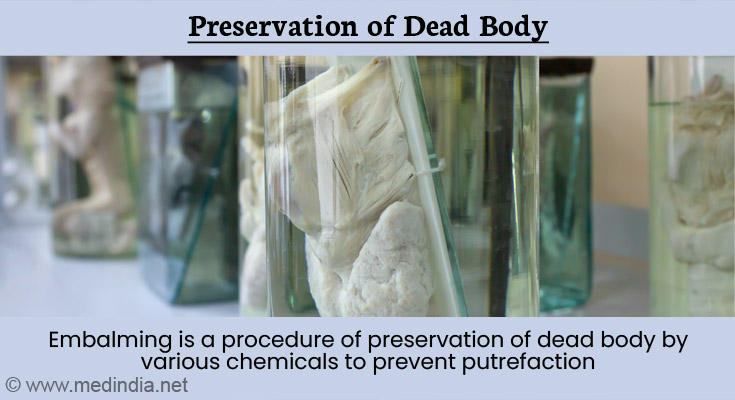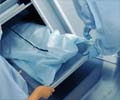- The Essentials of Forensic Medicine and Toxicology - (https://www.jaypeedigital.com/book/9789352701032)
- Human body preservation - old and new techniques - (https://pmc.ncbi.nlm.nih.gov/articles/PMC3931544/)
- Cadaver embalming and fixing solutions from past to present - (https://www.clinmedkaz.org/download/cadaver-embalming-and-fixing-solutions-from-past-to-present-12551.pdf)
- Embalming: Principles and Legal Aspects - (https://www.jaypeedigital.com/book/9789389129748)
- Principles of forensic medicine including toxicology - (https://www.scribd.com/document/457956738/Nandys-Principles-of-Forensic-Medicine-3rd-Edition-pdf)
- EMBALMING FLUID-MODIFIED COMPOSITION FOR HOT AND HUMID PLACES - (https://www.ijmhr.org/ijar.4.3/IJAR.2016.265.pdf)
- Arterial embalming method of the cadaver and its application to research - (https://pubmed.ncbi.nlm.nih.gov/8237301/)
- The practice of ethics in the context of human dissection: Setting standards for future physicians - (https://pmc.ncbi.nlm.nih.gov/articles/PMC7366954/)
- MINISTRY OF LAW AND JUSTICE - (https://www.mha.gov.in/sites/default/files/250883_english_01042024.pdf)
- Mortician vs. Undertaker vs. Funeral Director: What is the Difference? - (https://www.goodwin.edu/enews/mortician-vs-undertaker-vs-funeral-director/)
About
Embalming is the process of treating a dead body with chemicals to prevent decay and preserve it. This process hardens tissues, bleaches and stiffens organs, and turns blood into a brownish substance. The stiffness caused by embalming stays for a longer time and significantly delays decaying, the stiffness does not go away like normal rigor mortis (Postmortem stiffening of dead body). This will ensure a delay in putrefaction until direct cremation. If done shortly after death, embalming can keep the body from decaying for many months. However, if done hours later, the body may partially decay and dry out, breaking down completely within a few months. It is commonly needed for transporting a body over long distances by road, rail, or air(1✔ ✔Trusted Source
The Essentials of Forensic Medicine and Toxicology
Go to source). For the best results, embalming should be done within 6–12 hours of death in summer or within 24–48 hours in winter(2✔ ✔Trusted Source
Human body preservation - old and new techniques
Go to source).
History of Embalming
Embalming was initially practiced by ancient cultures such as the Egyptians for religious purposes, believing that a preserved body ensured eternal life. They used natural preservatives like natron, herbs, and resins to prevent decomposition. Other civilizations, including the Chinchorro of South America and the Chinese, also embalmed their dead, employing methods such as honey immersion for preservation or to facilitate long-distance transportation. As embalming spread to Europe, it evolved through the Middle Ages, with techniques involving evisceration, alcohol immersion, and wrapping in tarred or waxed cloth. During the Renaissance, embalming methods became more scientific, with figures like Leonardo da Vinci and Frederik Ruysch introducing preservative injections into the body. By the 19th century, the practice had advanced significantly, with scientists like William Hunter and Jean Nicolas Gannal perfecting embalming fluids that laid the groundwork for modern techniques(3✔ ✔Trusted Source
Cadaver embalming and fixing solutions from past to present
Go to source).
Timeline of Embalming Evolution
15th - 16th Century: Leonardo da Vinci performed the first injection into a cadaver for study purposes.
18th - 19th Century: Thomas Holmes, known as the father of modern embalming, embalmed 4,000 soldier cadavers using alcohol, arsenic, and mercury.
1869: August Wilhelm von Hofmann discovered formaldehyde.
1886: Laskowski used glycerin to prevent cadavers from drying out and developed the Geneva solution.
1914: Deegener and Brendt introduced the paraffinization method.
1978: Prof. Dr. Gunther von Hagens invented the plastination technique(4✔ ✔Trusted Source
Embalming: Principles and Legal Aspects
Go to source).
Natural Preservation of Dead Bodies
- Freezing: Bodies can remain preserved for centuries in glaciers or snow-covered mountains due to ice and snow.
- Dry Cold: Corpses exposed to cold, dry air currents, like those at the St. Bernard Mountain morgue in Switzerland, naturally become mummified, which is called mummification
- Dry Heat: Extremely dry and warm climates, such as those in Egypt, Southwestern America, and Peru, can naturally preserve bodies as mummies.
- Soil Composition: Burials in soil rich in lime, tannin, arsenic, or salts of aluminium or copper can preserve bodies naturally.
Artificial Preservation of Dead Bodies
- Freezing: Storing the body at temperatures below 0°C, especially at -17°C or -18°C, can preserve it for many years or even indefinitely.
- Chemical Treatment: Using chemicals like arsenic-based compounds prevents decay caused by bacteria and the body's own enzymes.
- Mummification: Ancient methods, like those used in Egypt, involved preserving bodies with chemicals.
- Plastination: Used in anatomy for study purposes, this method replaces water and fat in body tissues with durable materials like silicone or rubber.
- Embalming: A method to preserve bodies using specific chemicals to delay decomposition(3✔ ✔Trusted Source
Cadaver embalming and fixing solutions from past to present
Go to source).
Mechanism of Embalming
Embalming modifies the structure of proteins by breaking down their natural properties, forming new chemical bonds between protein molecules, and converting them into a stable, solid lattice that resists bacterial decay and enzyme action. This process removes the proteins' ability to retain water, with stability maintained by a small amount of unreacted formaldehyde. As a result, proteins coagulate, tissues are firmed and preserved, organs are bleached and hardened, and blood turns into a brownish mass. Additionally, embalming induces chemical stiffening similar to rigor mortis, preventing its natural occurrence(1✔ ✔Trusted Source
The Essentials of Forensic Medicine and Toxicology
Go to source).
Methods of Embalming
Embalming involves injecting chemical fluid into tissues through artery, allowing it to diffuse into cells and tissues at the capillary level for preservation. The common methods include:
Gravity Injector
This method is simple, safe, and slow. A gravity bottle filled with embalming fluid is placed at a height (1 meter creates a pressure of 0.6 kg/cm²) and connected via plastic tubing to a needle or cannula inserted into the femoral artery. It requires more time, and fluid distribution may be uneven, leaving some areas untreated.
Electric Pump
Fluid is injected into the vascular system using an electric pump, with devices controlling the pressure and flow rate. Approximately 10 litres of arterial solution can be injected in about 30 minutes. This method provides higher pressure and is faster than the gravity injector.
Injection Method
This approach is used for cases involving traumatic deaths, autopsied cases and postmortem mutilations, requiring injections at multiple sites for thorough preservation(2✔ ✔Trusted Source
Human body preservation - old and new techniques
Go to source).
Injection and Drainage Techniques
Continuous Injection and Drainage: Fluid is injected and drained simultaneously.
Continuous Injection with Interrupted Drainage: Injection continues while drainage is paused periodically.
Alternate Injection and Drainage: Injection and drainage are performed one after the other.
Discontinuous Injection and Drainage: Both processes are paused and resumed as needed(1✔ ✔Trusted Source
The Essentials of Forensic Medicine and Toxicology
Go to source), (4✔ ✔Trusted Source
Embalming: Principles and Legal Aspects
Go to source).

Chemicals Used in Embalming
This preserving solution comprises the following components:
Formalin (1.5 litres): The primary .
Sodium borate (600 grams): A buffer to maintain pH.
Sodium citrate (900 grams): An anticoagulant to prevent blood clotting.
Glycerin (600 millilitres): A wetting agent and humectant to prevent tissue drying.
Sodium chloride (800 grams): Crystalloids to maintain cellular balance.
Eosin (30 millilitres, 1% solution): A dye for staining and improved specimen visibility.
Soluble wintergreen (90 millilitres): A fragrance.
Water (up to 10 litres): The vehicle for the other components(1✔ ✔Trusted Source
The Essentials of Forensic Medicine and Toxicology
Go to source).
Preservative: Inactivates saprophytic bacteria and delays decomposition by modifying the body's enzymes and lysins. Alcohol stabilizes formaldehyde and uniquely penetrates and diffuses rapidly into tissues without causing excessive hardening.
Buffers: Keep the tissue pH balanced and help preservatives work effectively on proteins in the cells.
Wetting Agents: Reduce water's surface tension, making it easier for embalming fluids to spread through blood vessels into tissues.
Anticoagulants: Prevent blood from clotting, making it easier to remove and allowing arterial fluids to flow smoothly(5✔ ✔Trusted Source
Principles of forensic medicine including toxicology
Go to source), (6✔ ✔Trusted Source
EMBALMING FLUID-MODIFIED COMPOSITION FOR HOT AND HUMID PLACES
Go to source).
Embalming Procedure
Normal Embalming (Arterial Embalming)
The embalmer should wear protective gear, including an impervious apron, cap, mask, and gloves. The body is placed on its back on the embalming table in embalming room, with clothing and any surgical dressings removed. Necessary embalming tools, embalming kits, embalming trocar and embalming instruments should be readily available before the procedure. The body is cleaned with antiseptic soap and warm water. If rigor mortis is present, it should be relieved by gently bending, massaging, and rotating the head. The nostrils are cleaned and filled with cotton soaked in arterial solution, while the cheeks may be filled with cotton soaked in the same solution. The mouth and eyes should be closed. If the eyes are sunken, arterial solution is injected into the orbits to restore them. The head should be elevated 8-10 cm on a head rest, and the feet raised to help in drainage. The anal and vaginal orifices should be sealed with cotton soaked in cavity fluid(7✔ ✔Trusted Source
Arterial embalming method of the cadaver and its application to research
Go to source).
Choice of Vessels
The vessels closest to the heart provide better embalming results, particularly for drainage. Single-point injections may leave certain areas inadequately fixed, so multiple injection sites are necessary for traumatic deaths, autopsies, or postmortem mutilations. Injection is done in six points involving right and left common carotid arteries for the head and neck, the right and left axillary arteries for the upper limbs, and the right and left femoral arteries for the lower limbs, with the help of embalming needle injectot. The embalming fluid is directed through these arteries towards the heart. After each injection, the vessels should be ligated to prevent fluid leakage(1✔ ✔Trusted Source
The Essentials of Forensic Medicine and Toxicology
Go to source), (6✔ ✔Trusted Source
EMBALMING FLUID-MODIFIED COMPOSITION FOR HOT AND HUMID PLACES
Go to source).
Cavity Embalming (Closed Cavity Treatment)
Cavity embalming involves replacing the fluids in the body’s internal cavities with embalming chemicals, using an aspirator and a 30 cm trocar. The embalmer makes a small incision above the navel (about two inches superior and two inches to the right), inserts the trocar into the chest and abdominal cavities, and aspirates the contents. Afterward, the cavities are filled with concentrated formaldehyde-based chemicals. The incision is closed either by suturing or applying a trocar button. The following fluid is recommended:(1✔ ✔Trusted Source
The Essentials of Forensic Medicine and Toxicology
Go to source)
- Formaldehyde: 5-37%
- Methanol: 9-56%
- Phenol: 3-5%
- Glycerol: 5-10%
- Surfactants: 5-2%
- Buffers: As needed to maintain pH(6✔ ✔Trusted Source
EMBALMING FLUID-MODIFIED COMPOSITION FOR HOT AND HUMID PLACES
Go to source)
Hypodermic Embalming
Hypodermic embalming is a supplementary technique that involves injecting embalming chemicals directly into the tissue using a hypodermic needle and syringe. This method is applied when arterial fluid has not adequately reached certain areas during the main embalming procedure(1✔ ✔Trusted Source
The Essentials of Forensic Medicine and Toxicology
Go to source).
Surface Embalming
Surface embalming is another method where embalming chemicals are applied directly to the skin and other superficial areas. This technique is often used to preserve and restore damaged or compromised areas, such as those affected by trauma, decomposition, cancer, or skin donation(1✔ ✔Trusted Source
The Essentials of Forensic Medicine and Toxicology
Go to source).
Prerequisites and Ethical Considerations of Embalming
Before embalming a body, proper legal documentation is essential. This includes confirming the identity of the body, ensuring it is intact, and verifying that it is not decomposed or infectious. Consent is required to prevent any allegations of organ removal, mutilation, or other issues. A death certificate from a registered medical officer who attended the deceased during their final illness is crucial, as well as a no-objection certificate from the police and clearance from relevant authorities such as the embassy or consulate, especially for foreign nationals(8✔ ✔Trusted Source
The practice of ethics in the context of human dissection: Setting standards for future physicians
Go to source).
In medicolegal cases, embalming before an autopsy can lead to serious legal consequences under Section 238 of BNS (Bharatiya Nyaya Sanhita), as it may be seen as tampering with evidence. Disrespect or mutilation of a body can also lead to punishment under Section 301 of BNS. The Anatomy Act allows bodies to be collected for medical purposes only under specific conditions, such as when the death occurred in a state hospital or public area, the body is unclaimed for 48 hours, and the police have given clearance. It is recommended to follow a strict procedure with the required forms to avoid legal(9✔ ✔Trusted Source
MINISTRY OF LAW AND JUSTICE
Go to source).
Workers in Embalming
An embalming license is mandatory to do this procedure. Embalming is usually done by licensed Forensic or Anatomy specialty Doctors with the assistance of a mortician, which is done in an embalming room with the help of an embalming machine. After the embalming process, proper postmortem care or death care to the deceased should be given. Funeral directors, morticians, and undertakers support families during times of loss, helping with funeral preparation and arrangements. Morticians focus on duties such as embalming, preparing, and transporting the deceased, while undertakers is an older term often used for similar responsibilities. Funeral directors oversee broader tasks, including managing funeral homes and organizing services(10✔ ✔Trusted Source
Mortician vs. Undertaker vs. Funeral Director: What is the Difference?
Go to source).









